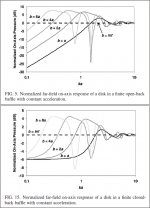Need some help here..
I understand about cabinet and baffle edge diffraction, but what about a flat disk with no baffle at all?
Like using a cone without any baffle but not exactly as even a cone has its surround and frame as a small baffle.
I find some stuff about a flat or round structures in a wave tank
Chapter 4 | Diffraction | Waves
where the wave is moving twards the structure and how the wave diffracts and scatters around the edges BUT , does the same diffraction and scattering happen when the wave is actually generated by the structure?
Can anyone point me to some articles on this ? Im not finding much on the net and may be just not asking the right question Ha.
I understand about cabinet and baffle edge diffraction, but what about a flat disk with no baffle at all?
Like using a cone without any baffle but not exactly as even a cone has its surround and frame as a small baffle.
I find some stuff about a flat or round structures in a wave tank
Chapter 4 | Diffraction | Waves
where the wave is moving twards the structure and how the wave diffracts and scatters around the edges BUT , does the same diffraction and scattering happen when the wave is actually generated by the structure?
Can anyone point me to some articles on this ? Im not finding much on the net and may be just not asking the right question Ha.
Last edited:
The short answer is yes. Any time an acoustic wave reaches the edge of an object(even if it is in motion) it will diffract around it. For a flat disk in free space, this results in a transition from flat response to a 6dB/oct slope at lower frequencies with some minor ripples at the transition. For a flat disk in the end of an infinitely long tube of the same size as the disk the response would transition from a flat response to a -6dB flat response at lower frequencies; basically the disk would be transitioning from half-space radiation to full-space radiation. Again, there will be some minor ripples at the transition.… what about a flat disk with no baffle at all?... does the same diffraction and scattering happen when the wave is actually generated by the structure?
For simple circular disks, you can actually calculate the response directly from their well documented radiation impedance which already has the diffraction “cooked in” to them. For more complicated radiator shapes, you can use diffraction simulators and set the baffle size infinitesimally larger than the radiator.
I just realized that I had a paper with the exact diffraction results you were asking about.
It is currently available for free download from the author here:
http://www.mellowacoustics.com/articles/Disk_in_a_circular_baffle.pdf
Book & papers
I attached the relevant images from the paper for the dipole and monopole cases.
For the “no-baffle” situation you are interested in, refer to the black “b=a” curves.
Linkwitz also had made available some off-axis curves from the author for the dipole case, that didn't make it into the paper.
See Section A3-5 here:
Electro-acoustic models
It is currently available for free download from the author here:
http://www.mellowacoustics.com/articles/Disk_in_a_circular_baffle.pdf
Book & papers
I attached the relevant images from the paper for the dipole and monopole cases.
For the “no-baffle” situation you are interested in, refer to the black “b=a” curves.
Linkwitz also had made available some off-axis curves from the author for the dipole case, that didn't make it into the paper.
See Section A3-5 here:
Electro-acoustic models
Attachments
Last edited:
- Status
- Not open for further replies.
